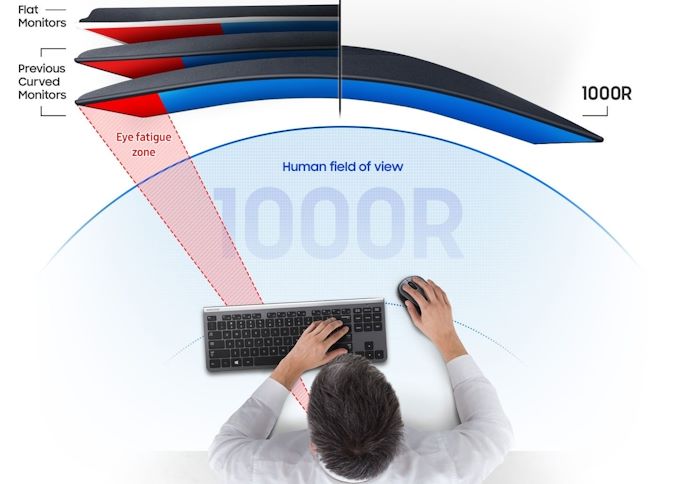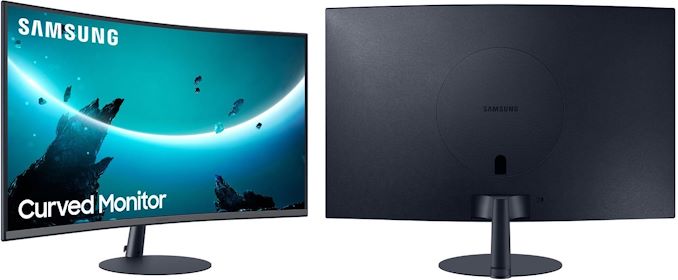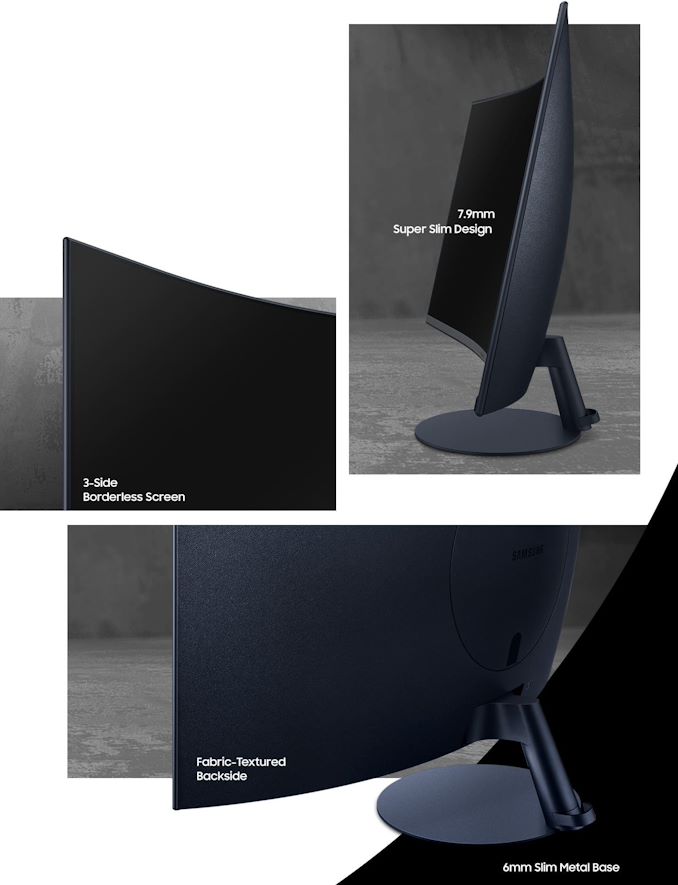Samsung Announces TD5 Monitors: Aggressive, 1000R Curved Office Displays
by Anton Shilov on March 3, 2020 10:00 AM EST- Posted in
- Monitors
- Displays
- Samsung
- FreeSync
- Curved Display
- Adaptive-Sync

As one of the major proponents of curved displays, Samsung has been applying curved panels to numerous monitors over the years. Many of these monitors have been aimed at gamers and prosumers, while for other market segments, such as SOHO, Samsung hasn't approached them with the same zeal for rounded displays. Last week, however, the company changed that, revealing its new T55 monitors that feature an aggressive 1000R curvature along with TÜV Rhineland’s Eye Comfort certification for certain models.
With the monitor market already beyond saturation with traditional displays, the key selling point for Samsung's TD5 displays is of course the 1000R curve. With most monitors on the market using 1500R or 1800R curves, the TD5s have a noticeably narrower curve than other monitors. Citing a a clinical study conducted by professor Seong-Joon Kim at Seoul National University Hospital, Samsung is promoting the new curved displays as provoking less eye strain than flat monitors, as they bring the whole picture closer to the human eye. Furthermore, Samsung says, because the 1000R curvature radius closely matches the human field of view, this is a more optimal curvature than less aggressive options. To that end, 1000R curvature is the core feature of the whole Samsung T55 lineup.
Overall, the T55 family consists of three models: the C24T55, C27T55 and C32T55, which offer 24-inch, 27-inch, and 32-inch diagonals respectively. All the LCDs use a 1920×1080 VA panel that offers a max brightness of 250 nits brightness, a 3000:1 contrast ratio, 4 ms response time, and a 75 Hz maximum refresh rate. The LCDs can display 16.7 million of colors and reproduce 119% of the sRGB, 88% of the Adobe RGB, and 88% of the DCI-P3 color spaces, which is quite good given their positioning (and the fact that their rivals usually support only the sRGB gamut).
The monitors feature a minimalist ‘3-side borderless’ design with a fabric-textured backside and use stands with a 6-mm slim metal base that can only adjust tilt. As for connectivity, the monitors have a DisplayPort input, a D-Sub input, and an HDMI port to ensure compatibility with both modern and legacy PCs.
Designed primarily for productivity/office workloads, the monitors are not exactly meant for entertainment uses, but Samsung nevertheless equipped them with a scaler that supports VESA’s Adaptive-Sync (and AMD FreeSync) variable refresh rate technology and added speakers to 27-inch and 32-inch models.
| General Specifications of Samsung's T55 Displays | |||
| C24T55 24-inch |
C27T55 27-inch |
C32T55 32-inch |
|
| Panel | 24" VA | 27" VA | 32" VA |
| Native Resolution | 1920 × 1080 | ||
| Maximum Refresh Rate | 75 Hz | ||
| Response Time | 4 ms | ||
| Brightness | 250 cd/m² | ||
| Contrast | 3000:1 | ||
| Backlighting | LED (?) | ||
| Viewing Angles | 178°/178° horizontal/vertical | ||
| Curvature | 1000R | ||
| Aspect Ratio | 16:9 | ||
| Color Gamut | sRGB: 119% AdobeRGB: 88% DCI-P3: 88% |
||
| Dynamic Refresh Rate Tech | VESA Adaptive-Sync (AMD FreeSync) |
||
| Pixel Pitch | 0.2767 mm² | 0.3113 mm² | 0.369 mm² |
| Pixel Density | 91.8 PPI | 81.6 PPI | 68.8 PPI |
| Inputs | DisplayPort D-Sub HDMI |
||
| Audio | audio in audio out |
audio in audio out 5W stereo speakers |
|
| USB Hub | - | - | - |
| MSRP | ? | ? | ? |
While Samsung lists all three T55 monitors on its website, the company yet has to reveal their exact launch dates or prices.
Related Reading:
- Samsung’s Odyssey Continues: Ultra-Curved QLED 49-Inch 240 Hz HDR1000 Monitor w/ Adaptive Sync
- Philips Reveals 346B1C 34-Inch 100 Hz Curved UltraWide Monitor with USB-C Docking
- HP’s E344c: A 34-Inch Curved Ultra-Wide Productivity Monitor
- Samsung Unveils CJ79 & CJ89 Curved LCDs: Quantum Dots, TB3 & USB-C
Source: Samsung DisplaySolutions (via Tom’s Hardware)













66 Comments
View All Comments
HowDoesAnyOfThisWork - Wednesday, March 4, 2020 - link
...*as a child*. Sigh....Atari2600 - Wednesday, March 4, 2020 - link
I have 2 of the 32" 4k 1500R curved U32R59C in work. Great job - not perfect, but getting close to it.I had (and still do, its at home now) a 40" 4k and did find viewing the two edges of the screen uncomfortable.
The 32" monitor here definitely needs a 4k screen before its relevant.
Ideally, Samsung would up the screen size to 34" and make the panel 4k with 1000R curve - I think that would be as perfect as a 4k productivity monitor could get.
ananandandtech - Wednesday, March 4, 2020 - link
Why doesn't anyone talk about the visual distortion caused by curving a display horizontally, but not vertically? If they're going to claim it is all about distance from the eyes, then in the context of curved displays the flatness of the vertical plane is now bending away from the viewer, right? A visually accurate display would need to bend along the vertical plane to some degree too it seems.boeush - Wednesday, March 4, 2020 - link
Firstly, manufacturing a cylindrical panel is much easier (and cheaper, and more scalable to high volumes) than making a spherical one. All you have to do is build it flat, then bend it (without breaking) around one direction. But you can't turn a flat sheet into a spherical surface without seriously stretching parts of it in a nonuniform manner: that sort of deformation would tend to destroy any crystalline layers, and would pose a challenge for any embedded circuitry, in the panel.Secondly, with widescreen formats the horizontal dimension matters much more than the vertical as far as spanning the visual field. Thus, the curve is always applied along the monitor's width, rather than its height.
Valantar - Thursday, March 5, 2020 - link
I am consistently fascinated by these nonsense claims that "X curvature better matches the human field of vision", as if this is somehow not dependent on the distance you're viewing from? If we simplify the human field of vision to be circular when "viewed" from above, it's rather common to think that a circle's circumference increases as the radius increases, right? So, say, an 1800r monitor will "match" the human field of vision just as well as a 1000r monitor when placed at a similar distance? Of course 1000r would allow you to place the monitor closer with this still being true, which I guess is what managers looking to shrink desks to save on office space might be looking for. "We got you this new 1' deep desk for ergonomic reasons! (Never mind that we can now squeeze you into an even smaller cubicle.)"teamlouish - Thursday, July 23, 2020 - link
Sometime in the article, you say TD5 and other times you say T55. I think its T55, as TD5 doesn't really show any results online. So the title of the article in the address bar and the H1 tag are wrong and need to be updated.